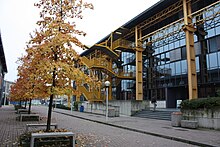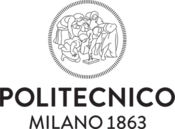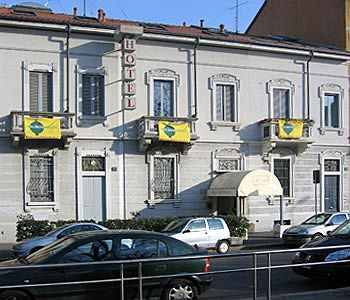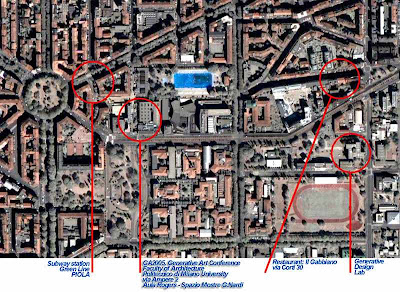Politecnico di Milano
The Politecnico di Milano is the largest technical university in Italy, with about 36,500 students. The rector of the university is professor Giovanni Azzone. The Politecnico offers undergraduate, graduate and higher education courses in Engineering, Architecture and Design.
The university is ranked as the 48th best technical university in the world according to the QS World University Rankings.
The logo is a sketch of Raphael's School of Athens.
History

Façade of the main seat of the Politecnico
The Politecnico was founded on 29 November 1863 by Francesco Brioschi, secretary of the Ministry of Education and rector of the University of Pavia. It is the oldest university in Milan. Its original name was Istituto Tecnico Superiore ("Higher Technical Institute") and only Civil and Industrial Engineering were taught. Architecture, the second main line of study at Politecnico, was introduced in 1865 in cooperation with the Brera Academy.
There were only 30 students admitted in the first year. Over the decades, most of students were men: the first female graduate from the university was in 1913.
In 1927 the Politecnico moved to piazza Leonardo da Vinci, in the district now known as Città studi (City of Studies). Politecnico's main facilities are still there today. At the time, it was named Regio Politecnico ("Royal Polytechnic"). The word Regio was removed as Italy was proclaimed a republic at the end of World War II. The historical building still in use today was designed and built by engineers and architects all graduated in the Politecnico itself.
In 1954, the first European centre of electronic computation was opened in Politecnico by Gino Cassinis and Ercole Bottani. In 1963 Giulio Natta received the Nobel Prize in Chemistry for his research on crystalline polymers, polypropylene in particular. In 1977, the satellite Sirio, jointly developed by Politecnico and other companies, was launched.
Since the end of the 1980s, the Politecnico has begun a process of territorial expansion that would have resulted in the opening of its satellite campuses in Lombardy and Emilia Romagna. A university programme in industrial design was started in 1993. In 2000, the politecnico's faculty of design was created with new courses in undergraduate and postgraduate programs of graphic & visual, fashion and interior design along with the already existent industrial design.
In April 2012, the university announced that, beginning in 2014, all graduate courses would be taught only in English.
Campuses

Entrance to the Design area of the Bovisa campus (Durando)
The University is distributed over 7 main campuses across Lombardy and Emilia Romagna:
- Campus Leonardo, located in piazza Leonardo da Vinci in Milan and active since 1927; from then on the campus expanded and today it comprises various parts close to each other (Leonardo, Bonardi, Clericetti, Mancinelli, Gran Sasso and Colombo).
- Campus Bovisa, located in the Bovisa district in Milan and active since 1989; campus Bovisa is today composed by campus Durando, opened in 1994, and campus La Masa, inaugurated in 1997.
- Campus Como, located in the city of Como and active since 1987.
- Campus Cremona, located in the city of Cremona and active since 1987.
- Campus Lecco, located in the city of Lecco and active since the first 90s of 20th century.
- Campus Mantova, located in the city of Mantova and active since 1999; the seat is the former Orphanage of the Mercy, designed in the late 18th century by the architect Paolo Pozzo.
- Campus Piacenza, located in the city of Piacenza and active since 1997; the seat is the Barracks of the Snow, a building of the 16th century.
Academics
Politecnico di Milano offers several three-year undergraduate courses, two-year graduate courses, one-year master courses and PhD programs in the fields of engineering, architecture and design. The Politecnico offers 32 first level (Bachelor) degree programmes. Among these, there is an on-line course in Computer Engineering, the first on-line academic course in Italy. This wide range of different curricula is tailored to the needs of its territory (the Lombardy region), which is one of the most developed industrial areas in Europe.
In 2011 the university was ranked as the 48th best technical university in the world, in the QS World University Rankings. This was a 9-positions growth from the 57th position in 2009, and a 15-position growth since the 63rd position in 2008. In 2009 an Italian research ranked it as the best in Italy over indicators such as scientific production, attraction of foreign students, and others.
Politecnico was ranked the best university for Engineering and among the top big universities in Italy in the CENSIS-Repubblica Italian University rankings for academic year 2011-2012.
Politecnico maintains several relations with foreign universities and offers a wide range of international projects for student exchange, The university encourages the enrollment of foreign students by providing several courses in English. It participates in the ENTREE network for student exchange among Electrical Engineering colleges in Europe, it is a member of Top Industrial Managers for Europe (TIME) network and it contributes to IMCC organisation.
Politecnico di Milano is part of several international student exchange networks: Athens, Erasmus, Erasmus Mundus, Medes, Pegasus and Unitech, with agreements with about 400 foreign universities. Furthermore, Politecnico is planning to offer all graduate courses in english since 2014.
The Alta Scuola Politecnica is a joint institution of Politecnico di Milano and Politecnico di Torino addressed to young talents who want to develop their interdisciplinary capabilities for leading and promoting innovation, and runs in parallel to the two-year programmes of laurea magistrale (graduate courses).
Admission
Engineering
The admission in the undergraduate programme in Engineering in the Politecnico is bound to an admission test, aimed to verify the starting preparation of every student. The main goal of this test is to point out the lacks of the aspiring students and, in case, to assign them an extra course. Only some programmes have a strictly limited number of places, even if the Academic Senate fixes an approximate maximum number of students for every programme. The admission test for any Engineering school, except Construction Engineering, is divided in four parts, each about one of the following general subject: English Language; Logic, Mathematics and Statistics; Verbal Comprehension; Physics.
Architecture, Design and Construction Engineering
Architecture, Design and Construction Engineering schools have a limited number of students admitted every year and the selection is based on a national test administered by the Ministry of Education. The test is divided into five parts, each about one of the following general subject: Logic and General Knowledge; History; Drawing and Representation; Mathematics and Physics.
Graduate Programmes
Admission to the graduate programmes in the Politecnico requires an undergraduate degree and a set of requirements specific for each school, such as the time spent in obtaining the undergraduate degree or the grade point average scored during the undergraduate programme.
The Politecnico also offers courses of study for the title of Dottore di Ricerca (Ph.D.), MBA courses, and other postgraduate courses. MIP Business School is one of the most prominent management school in Italy and was ranked as 96th best business school in the world by Financial Times in 2011.
Organization
An interesting part of student life are "copy centers". During the 1970s, two copy centers were born: CLUP and CUSL (the former from left-wing student groups, the latter with a Catholic, conservative student base), as an effort from students to solve their own problems (such as the cost of books and sharing of lecture notes). They have been the only copy centres within Politecnico's premises for a long time. They are important just for historical and political reasons, as nowadays there are plenty of alternative facilities in Politecnico's district, Città Studi. CLUP moved outside the university premises in 2001 and does not exist anymore; CUSL still exists and keeps its links with the Comunione e Liberazione Catholic movement.
A well known structure is the ISU (a generic term which in Italian university describes additional student facilities such as open libraries, lending of portable PCs, cafeterias and study spaces), dedicated to Luigi Divieti. A legend talks of the "Pianist of ISU", a man who is supposed to be living there since he was born some 50 years ago, and to be a hopelessly old student of the university.
Inside the Leonardo campus students can find the seat of the Educafe. Educafe has been conceived as an innovative space inside the Politecnico, where students can meet up or freely surf the net. Educafe, despite its very limited size, is also a meeting center, where cultural events are organized every months.
Among the student organizations:
- BEST Milano (Board of European Students of Technology) a European non-profit and politically neutral organization, focus on Empowered diversity, done by students for the students and present in more than 30 countries.
- ESN (European Student Network) a non-profit organization, gathering exchange student and encouraging exchange project.
- Euroavia an organization founded to gather aerospace students of the Politecnico and make easy to contact other aerospace students in Europe.
- Associazione Ingegneri Ambiente e Territorio (Associazione Ingegneri Ambiente e Territorio) a student association composed by students in Environmental Engineering.
- Teatro delle Biglie (English translation: 'Theatre of the Marbles') an independent non-profit organization, born as theatre association.
- Poul (Politecnico Open Unix Labs) a student association composed by student interested in Unix-like systems.
- IEEE Student Branch of the Politecnico di Milano.
Departments
The Department represents the institutional seat for conducting research activities in related sectors as indicated in its own scientific project, regarding contents and/or methods as well as the development of the corresponding educational activities skills throughout the university.
There are 16 Departments which are active in the Politecnico di Milano:
- Aerospace Engineering
- Architectural Projects
- Architecture and Planning (DIAP)
- Bioengineering
- Chemistry Materials and Chemical Engineering "Giulio Natta"
- Electrical Engineering
- Electronics and Information (DEI)
- Energy
- Building and Environment Sciences and Technology (BEST)
- Environmental, Hydraulic, Infrastructures and Surveying Engineering (DIIAR)
- Industrial Design, Arts, Communication and Fashion (INDACO)
- Management, Economics and Industrial Engineering (DIG)
- Mathematics "Francesco Brioschi"
- Mechanics
- Physics
- Structural Engineering (DIS)
Courses
- Bachelor of Science in Architecture
- Master of Science in Materials Engineering
- Bachelor of Science in Urban Planning
- Master of Science in Energy Engineering (specialization in Energy Engineering for an Environmentally Sustainable World )
- Master of Science in Architecture
- Master of Science in Mechanical Engineering
- Master of Science in Architecture (specialization in Architectural Design)
- Master of Science in Automation and Control Engineering
- Master of Science in Urban Planning and Policy Design
- Master of Science in Computer Engineering
- Master of Science in Product Service System Design
- Master of Science in Computer Engineering (specialization in Engineering of Computing Systems)
- Master of Science in Civil Engineering (specialization in Environmental Risks Mitigation)
- Master of Science in Architectural Engineering
- Master of Science in Management Engineering
Library System
The library system of the Politecnico counts more than 470.000 records distributed all over the libraries in the campuses. The system is made up of Central Libraries (amongst which the most important ones are the 'Central Engineering Library' and the 'Central Architecture Library') and Teaching Libraries, set up to help students preparing their exams. The titles registered in the library system can be consulted through an OPAC (Online Public Access Catalogue).
Since autumn 2004, the Politecnico owns a publishing trademark, Polipress, created mainly to publish researches by the Politecnico community. Polipress publishes also the free Politecnico periodical.
Research
The Politecnico di Milano participates to European and international networks of research. In year 2004 alone, about 60 large scale, multi-year international research projects have been initiated or participated by the Politecnico, just in the context of the European Research framework.. As of 2012, Politecnico takes part in over 132 current FP7 research projects.
Many scientists working at the Politecnico di Milano have received awards and recognition by the scientific community: among them, the most famous is undoubtedly Giulio Natta, the only Italian Nobel laureate for Chemistry to date (1963), who was also the head of the Department of Industrial Chemistry at Politecnico. As of 2005, a number of professors at Politecnico are ACM or IEEE fellows.
The Politecnico participates in associations and consortia for applied research, has offices to assist technological transfers and continuing education for professionals. The university supports the establishment of research spin-offs (20 spin-offs from 2000 to today), and also of high-tech companies during their start-up phase, with a structure named Acceleratore d'Impresa (Start-up Incubator).
Research Areas
Following are the research activities in which Politecnico di Milano is involved. They are divided up into groups, as presented at the 2007 international assessment (peer review).
To allow for easier identification, the research can be classified according to the following macro-areas.
- Aeronautics and space
- Environment
- Cultural heritage
- Biotechnology for health
- Chemistry, materials and nanotechnologies
- Citizens, enterprises and governance
- Building construction, infrastructures and landscape
- Energy
- Phisics
- Mathematics
- Products and industrial processes
- Information society technologies
- Transport
Departments
- The Department represents the institutional seat for conducting research activities in related sectors as indicated in its own scientific project, regarding contents and/or methods as well as the development of the corresponding educational activities skills throughout the university.
- There are 16 Departments which are active in the Politecnico di Milano:
- Aerospace Engineering
- Architectural Projects
- Architecture and Planning (DIAP)
- Bioengineering
- Chemistry Materials and Chemical Engineering "Giulio Natta"
- Electrical Engineering
- Electronics and Information (DEI)
- Energy
- Building and Environment Sciences and Technology (BEST)
- Environmental, Hydraulic, Infrastructures and Surveying Engineering (DIIAR)
- Industrial Design, Arts, Communication and Fashion (INDACO)
- Management, Economics and Industrial Engineering (DIG)
- Mathematics "Francesco Brioschi"
- Mechanics
- Physics
- Structural Engineering (DIS)
Research Lines
Advanced software architectures and methodologies
- Aerodynamics and Fluid Mechanics
- Aeroservoelasticity, Flight Mechanics and Controls
- Algebraic and combinatorial methods in geometry and in theoretical computer science
- Applied Catalysis
- Applied differential models
- Applied Economics
- Applied Physical Chemistry for Processes and Materials Development
- Applied systems analysis and operations research
- Approximation theory: numerical and geometrical models
- Architectural and urban design
- Architectural heritage and landscape preservation and management
- Architecture and Urban design
- Artificial Intelligence and Robotics
- Banach space theory
- Basic Organic - Green Chemistry and Bioorganic Analytical Methodologies
- Biocatalysis and Biotransformations
- Biomaterials and Functionalization treatments
- Biomechanics
- Biomimetic engineering and micro-nanotechnology
- Calculus of Variations and Differential Equations
- Chemical Engineering: Modeling, Simulation and Control
- Circuits and Systems: Theory and Applications
- Clean Power Generation
- Combustion and Propulsion
- Communications
- Computational Mechanics of Materials and Structures
- Concrete Structures
- Control systems
- d.com - Design of Communication
- DeCH – Design for Cultural Heritage
- Degradation of materials and durability of constructions and plants
- Design
- Design & Metadesign
- DIS – Design and Innovation for Sustainability
- Dynamics and Vibrations
- Dynamics of Structures
- Earthquake Engineering and Seismic Risk
- Electric power systems
- Electrical and electronic measurement
- Electrical Machines, Converters and Drives
- Energy & Environment Engineering
- Engineering Electromagnetics
- Environmental Chemical Technology
- Environmental Technologies for Pollution Prevention and Control
- Ergonomics & Design
- Fashion & Textile Design
- Fluorinated Materials: Reactivity, Self-Organization and Functions
- Geometrical Methods in Mathematical Physics
- Ground Vehicles
- Historical Masonry Structures: Damage and Diagnosis
- History of architecture
- History of architecture and restoration
- History of Technology
- Hydraulic Engineering
- Hydrology and Hydraulic Engineering Works
- Information Systems
- Instruments and methods of representation
- Interiors
- Logistics, Operations and Industrial Engineering
- Machine Design
- Magnetic and Semiconductor Nanostructures
- Management
- Management
- Manufacturing and Production System
- Materials
- Materials
- Mathematical Modelling and Scientific Computing (MOX)
- Mathematical problems in kinetic and soft matter theories
- Mathematics Education Project
- Measurements and Experimental Techniques
- Mechatronic design of automatic machines and rehabilitation devices
- Methods and Tools for Product Design
- Microelectronics and emerging technologies
- Mobility and territory
- Networks
- Organic Functional and Nanostructured Materials: synthesis, characterization and modeling
- Photonics for health, food and cultural heritage
- Physiological modelling and non invasive diagnostics
- POLYMERIC MATERIALS / development of new materials and applications
- Positron spectroscopy of solids
- Power systems and safety
- Production
- ProjectProduct
- Radiation detection and measurements
- Regional, urban and environmental planning
- Rehabilitation Engineering and Technology
- Sensors and Instrumentation
- Signals
- Soil-Structure Interaction under Environmental Loading
- Solid state lasers and photonic devices
- Space Systems
- Spectroscopy of solids and surfaces based on electromagnetic radiation and on electron beams
- Stochastic Models
- Structures and Materials
- Surface Engineering and Advanced Coatings
- Surveying, Geodesy, Photogrammetry, GIS, Geomatics and Cartography
- System architectures
- Technologies for therapy
- Termodynamics and Heat Transfer
- Territorial Governance and Planning
- Theory, History and Design of Interiors
- Thermal and Hydraulic Machines
- Time, mobility and safety planning
- Transportation Infrastructures and Engineering Geology
- Ultrashort light pulse generation and application to the study of ultrafast phenomena in the matter
- Visual Perception and Representation
- Web, multimedia and databases
Student life

A building in Bovisa campus
Student fees at the Politecnico depend on the income of the family of the student. They range between 150 €/year and 3000 €/year. Students with good grades are granted partial or full rebates, in addition to various kinds of scholarships.There are many scholarships for international students as part of its recent internationalization program.
Most Italian universities do not offer accommodation for their students on campus. Politecnico has a limited number of approximately 2000 beds available for students. Most students from outside the city are either commuters or renting. It is customary for students to share flats in small groups of 3 or 4 people, as rent rates are very expensive in the city.
The campuses Leonardo and Bovisa are covered by a Wi-Fi network, connected and interoperable with the Eduroam service. Most public areas of the campuses are covered by wi-fi.
Professional opportunities and statistics
Politecnico Di Milano is a well known university in Europe. The 2007 graduate survey shows that 80% of graduates of the Politecnico di Milano find a job within three months from graduation, and almost 95% within six months. The figures are similar for the bachelor and the masters level graduates. A specialized "Career Service" facilitates contacts between graduates and the industry, it invites companies for presentations and prepares statistics about graduated students. It posts almost 200 job offers per month and arranges 90 recruitment events per year (which mostly consist of company presentations with arranged interviews).
Approximately 55% of undergraduate students complete their studies on time, and approximately 80% of them graduate within an additional year. Similar figures apply to graduate students.
Student politics
Currently, the three main political groups in student's elections are:
- Lista aperta per il diritto allo studio ("Open list for the right to study"), whose members are also usually part of the Catholic movement Comunione e Liberazione. The movement is arguably right-wing, even if it defines itself as "not politically oriented";
- La Terna Sinistrorsa ("The left-hand coordinate system"), the left-wing organization; the denomination is a pun on the Cartesian three-dimensional coordinate system.
- Svolta Studenti - La Students' Union del Politecnico di Milano ("The Student's Union of Politecnico di Milano"), which takes inspiration from the Anglo-Saxon student-groups, is not politically oriented and its main purpose is to provide services to students.
Other smaller groups (both right-wing) are:
- Terzopolo - Centro Destra Universitario ("Third pole - University centre-right"), connected to the right-wing political coalition Popolo della Libertà;
- Movimento Universitario Padano ("Padanian university movement"), linked to the Lega Nord party.
Participation in student elections is generally low, typically below 15%, as a result of low interest in issues and the low influence of elected students on the academy's decisions.
Notable Alumni

Gio Ponti

Giulio Natta

Renzo Piano with the President of Italy Giorgio Napolitano
Main page: Alumni of the Politecnico di Milano
- Gae Aulenti (architect)
- Achille Castiglioni (architect 1918-2002)
- Gian Paolo Dallara (engineer and entrepreneur)
- Elio (musician)
- Gianfranco Ferré (fashion designer 1944-2007)
- Carlo Emilio Gadda (engineer and writer 1893-1973)
- Francesco Giavazzi (economist)
- Giulio Natta (chemist and Nobel Laureate 1903-1979)
- Adriano Olivetti (chemical engineer and entrepreneur 1901-1960)
- Renzo Piano (architect)
- Giovanni Battista Pirelli (entrepreneur 1848-1932)
- Gio Ponti (architect 1891-1979)
- Ernesto Nathan Rogers (architect 1909-1969)
- Aldo Rossi (architect 1931-1997)
- Saul Steinberg (cartoonist and illustrator 1914-1999)
- Giuseppe Terragni (architect 1904-1943)
- Marco Zanuso (architect and designer 1916-2001)































































No comments:
Post a Comment